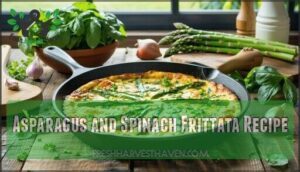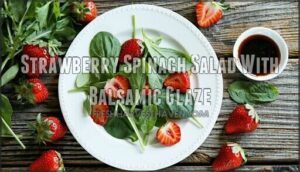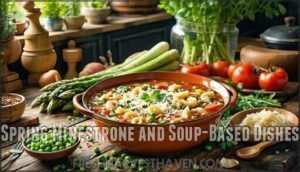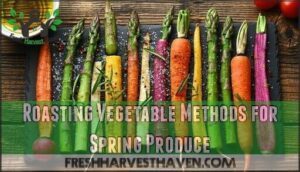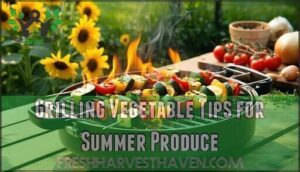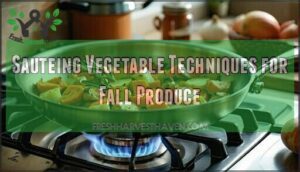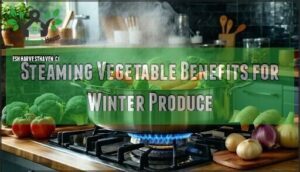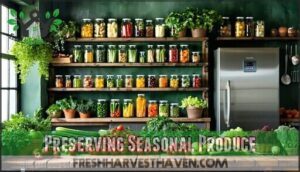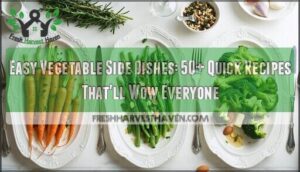This site is supported by our readers. We may earn a commission, at no cost to you, if you purchase through links.
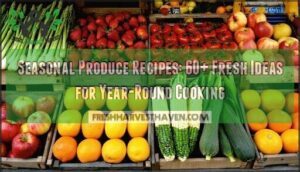 You’ll discover incredible flavor when you cook with seasonal produce recipes that celebrate nature’s perfect timing.
You’ll discover incredible flavor when you cook with seasonal produce recipes that celebrate nature’s perfect timing.
Spring brings tender asparagus and sweet strawberries, while summer delivers juicy tomatoes and crisp corn.
Fall offers hearty squash and apples, and winter provides robust root vegetables and citrus fruits.
Shopping seasonally saves money since you’re buying what’s abundant and local.
Your taste buds will thank you—seasonal ingredients are at their nutritional peak and bursting with flavor.
Plus, you’ll naturally vary your diet throughout the year, keeping meals exciting and your body nourished.
The secret lies in knowing which techniques bring out each season’s best qualities.
Table Of Contents
- Key Takeaways
- Seasonal Produce Overview
- Spring Season Recipes
- Cooking Techniques Guide
- Preserving Seasonal Produce
- Budget Friendly Meal Planning
- Frequently Asked Questions (FAQs)
- Do seasonal ingredients make a difference?
- What are seasonal vegetable cooking ideas?
- How do you make the most of spring vegetables?
- What are the best spring food recipes?
- What’s in season for cooking?
- What ingredients can I use for seasonal cooking?
- Is seasonal produce cheaper in season?
- How do I celebrate the start of summer produce?
- What are some summer vegetable recipes?
- Is fresh produce available year-round?
- Conclusion
Key Takeaways
- You’ll save 10-25% on groceries by shopping seasonally, since abundant produce costs less and delivers up to 30% more nutrients than out-of-season alternatives.
- You’ll maximize flavor and nutrition by cooking with produce at its peak season – spring asparagus, summer tomatoes, fall squash, and winter citrus each offer distinct advantages when fresh.
- You’ll extend your seasonal bounty year-round through simple preservation methods, like blanching and freezing vegetables, canning tomatoes, or dehydrating fruits to maintain peak flavors.
- You’ll master essential cooking techniques that complement each season’s produce – roasting spring vegetables at 425°F, grilling summer produce for smoky depth, sautéing fall harvests, and steaming winter vegetables to preserve nutrients.
Seasonal Produce Overview
You’ll discover that seasonal produce offers peak flavor, higher nutrition, and better value when you shop with nature’s calendar.
Fresh, locally-sourced fruits and vegetables contain up to 30% more nutrients than their out-of-season counterparts while saving you 10-25% on grocery costs.
Benefits of Eating Seasonal Produce
Seasonal produce transforms your kitchen into a nutrient-rich powerhouse. You’ll discover enhanced flavors, superior nutrition, and impressive cost savings when you embrace nature’s timing. Fresh picks deliver maximum vitamins—broccoli grown in fall contains nearly twice the vitamin C of spring varieties. Your wallet benefits too, with seasonal savings of 10-25% compared to out-of-season options.
Nature’s timing delivers peak flavors and maximum savings—shop seasonally, eat brilliantly.
Here are five compelling reasons to prioritize seasonal ingredient cooking:
- Nutrient Boost: Peak-ripeness fruits contain 40% more phytonutrients than stored alternatives
- Fresh Picks: Locally harvested produce reaches markets within 24-48 hours of picking
- Seasonal Savings: Abundant supply drives prices down substantially during peak seasons
- Eco Benefits: Reduced transportation cuts your carbon footprint substantially
- Healthy Habits: Diverse seasonal eating prevents nutrient deficiencies and food boredom
These fresh produce meals support local farmers while delivering unmatched taste and nutrition for your seasonal food ideas. By choosing seasonal eating practices, you can make a positive impact on your health and the environment.
Identifying Seasonal Fruits and Vegetables
Recognizing seasonal produce starts with understanding nature’s rhythm. Spring produce like asparagus and strawberries signal winter’s end, while summer brings tomatoes and corn. Fresh produce reaches peak flavor during its natural harvest times.
Your fruit calendar becomes invaluable here – it’ll show you when peaches ripen in July or when winter squash appears in October. Seasonal guides help you navigate farmers markets confidently. Look for fresh picks that feel firm and smell fragrant.
Creating your own veggie tracker helps you remember what’s coming next. Seasonal fruits and seasonal vegetables follow predictable patterns – strawberries in May, tomatoes in August, apples in September. You’ll taste the difference when produce is truly in season.
Storing Seasonal Produce for Freshness
Your seasonal produce deserves proper produce storage to maintain peak freshness tips.
Store leafy greens with damp paper towels in airtight containers. Keep ethylene producers like bananas separate to prevent premature ripening.
Stand asparagus upright in water, covering tops to extend shelf life.
Root vegetables thrive in cool, dark spaces.
These storage methods and preserving methods guarantee your farm to table recipes showcase ingredients at their best, supporting food safety while maximizing flavor from local sourcing.
Spring Season Recipes
Spring brings nature’s fresh start to your kitchen, and you’ll love how these vibrant recipes celebrate the season’s best produce.
From tender asparagus to sweet strawberries, spring ingredients offer bright flavors that make every meal feel like a celebration of renewal.
Asparagus and Spinach Frittata Recipe
This garden frittata transforms spring’s bounty into a protein-packed powerhouse.
You’ll master Frittata Basics by whisking eggs with fresh asparagus and nutrient-rich spinach.
Asparagus Tips: snap off woody ends before chopping.
Spinach Benefits include iron and vitamins that complement Egg Recipes perfectly.
This versatile dish works for Breakfast Ideas or dinner, showcasing spring recipes at their finest.
Seasonal produce shines in vegetable breakfast bowls like this one-pan wonder.
Strawberry Spinach Salad With Balsamic Glaze
This vibrant strawberry spinach salad transforms fresh greens into a showstopper that’ll make your taste buds dance. The sweet berries paired with nutrient-packed spinach create the perfect balance for healthy seasonal eating.
Here’s your game plan:
- Select baby spinach for tender texture and maximum spinach benefits
- Choose perfectly ripe strawberries for natural sweetness in your seasonal fruit dishes
- Drizzle homemade balsamic dressing or experiment with glaze recipes for bold flavor
This summer salad recipe showcases seasonal produce at its finest.
Spring Minestrone and Soup-Based Dishes
Spring’s bounty transforms ordinary minestrone recipes into vibrant celebrations of seasonal produce.
You’ll love combining fresh asparagus, peas, and tender greens with quality broth and small pasta like ditalini. These Italian soups showcase spring vegetables at their peak, creating hearty soups that satisfy without overwhelming.
Vegetable soup variations let you experiment with whatever’s fresh in your garden or market. By incorporating best spring recipes into your meal planning, you can create delicious and nutritious dishes that highlight the flavors of the season.
| Vegetable | Prep Time | Cooking Method | Season Peak | Flavor Profile |
|---|---|---|---|---|
| Asparagus | 5 minutes | Light sauté | Early spring | Fresh, grassy |
| Peas | 2 minutes | Quick blanch | Mid-spring | Sweet, tender |
| Leeks | 8 minutes | Slow sweat | Late spring | Mild, oniony |
| Swiss Chard | 3 minutes | Quick wilt | All spring | Earthy, mineral |
| Artichokes | 15 minutes | Steam first | Peak spring | Nutty, complex |
Cooking Techniques Guide
You’ll master these four essential cooking techniques to reveal the full potential of seasonal produce throughout the year.
Each method is specifically designed to complement the natural characteristics of vegetables at their peak season.
Roasting Vegetable Methods for Spring Produce
Perfect Roasting Tips start at 425°F for crisp-tender Spring Vegetables. Toss asparagus, Roasted Carrots, and radishes in olive oil with salt and pepper.
Vegetable Blends need consistent sizing—cut everything uniformly. Roasting Times vary: tender asparagus takes 10-15 minutes, while firmer carrots need 25-30 minutes.
Don’t overcrowd your pan or you’ll steam instead of roast. These roasting techniques transform your spring produce recipes into caramelized perfection.
For the best results, try using roasted spring vegetables in your next dish.
Grilling Vegetable Tips for Summer Produce
Three simple BBQ tips transform your summer vegetable meals: preheat your grill to medium-high for perfect grill marks, thread smaller pieces onto veggie skewers to prevent falling through grates, and brush with oil before cooking.
Grilled greens like zucchini and bell peppers add smoky depth to summer salads. These grilling tips maximize your seasonal produce in delicious vegetable recipes.
Achieving distinct grill mark patterns requires careful temperature control and technique.
Sauteing Vegetable Techniques for Fall Produce
While summer grilling brings out natural sweetness, sauteing vegetables transforms fall vegetable harvests into comforting meals.
Heat your vegetable saut pan over medium-high heat with high smoke point oils. Add aromatics like onions first, then heartier roasted root vegetables like carrots and parsnips.
This quick cooking method preserves nutrients while creating caramelized edges. Master these saute methods for flavorful autumn recipes using seasonal produce.
Pan frying fall recipes couldn’t be simpler. To achieve the best results, understanding the proper use of a saute pan is essential for perfecting your cooking techniques.
Steaming Vegetable Benefits for Winter Produce
Steaming winter produce reveals Winter Nutrition while preserving delicate flavors.
This gentle cooking method retains vitamins that boiling destroys, making winter root vegetables like carrots and parsnips incredibly nutritious.
Your Vegetable Prep becomes effortless—simply cut uniform pieces for even cooking.
These perfectly steamed vegetables enhance Healthy Soups and Winter Stews with vibrant colors and tender textures.
Master these steaming methods to create hearty vegetable broths that transform seasonal produce into satisfying comfort foods all season long.
Preserving Seasonal Produce
You don’t have to watch your summer tomatoes turn to mush or your fall apples go bad when you know the right preservation techniques.
Learning to can, freeze, dehydrate, and pickle your seasonal bounty means you’ll enjoy peak flavors all year long while saving money and reducing food waste.
Canning and Freezing Techniques for Fruits and Vegetables
After mastering basic cooking techniques, Food Preservation becomes your next frontier.
Canning Methods require pressure canning for vegetables due to their low acidity, while water bath canning works perfectly for high-acid fruits.
Freezing Tips include blanching vegetables first to preserve up to 90% of vitamins. Here’s your seasonal produce guide for preserving:
- Canning tomatoes – Use tested recipes for safe acidity levels
- Freezing garden vegetables – Flash freeze on trays first
- Vegetable Blanching – Boil briefly, then ice bath immediately
- Fruit Storage – Remove air to prevent freezer burn
These methods preserve flavors year-round while maintaining nutritional value. For successful canning, having the right canning supplies is essential to guarantee safety and quality.
Dehydrating and Pickling Methods for Preserving
Beyond simple storage, dehydrating and pickling transform your seasonal bounty into flavorful treasures that last months. Dehydrating Fruits concentrates natural sweetness while Pickling Vegetables adds tangy punch to winter meals.
Here’s your Food Preservation toolkit:
- Set dehydrator temperature to 135°F for fruits, 125°F for vegetables
- Create quick pickles using equal parts vinegar and water
- Slice produce uniformly for even drying
- Use Canning Methods with proper sterilization for shelf-stable pickles
- Store dehydrated items in airtight containers away from light
These Preserving techniques keep your seasonal produce vibrant year-round.
Fermenting and Infusing Recipes for Seasonal Produce
The art of Fermented Foods transforms your seasonal produce into probiotic powerhouses that’ll last months.
You’ll discover how simple salt and time create complex flavors while preserving nutrients better than most methods.
Seasonal Kimchi made with spring radishes or summer cabbage develops incredible depth over weeks. Fruit Vinegars from strawberries or pears add bright acidity to winter salads. Infused Oils capture herb essence perfectly.
| Method | Seasonal Examples |
|---|---|
| Fermented Vegetables | Spring radish kimchi, summer sauerkraut |
| Fruit Vinegars | Strawberry vinegar, pear vinegar |
| Infused Oils | Basil oil, garlic scapes oil |
| Pickled Fruits | Pickled cherries, pickled rhubarb |
| Fermented Beverages | Rhubarb kvass, berry kombucha |
Pickling Tips: Use quality salt and clean preserving equipment for consistent results.
Tips for Preserving Produce to Enjoy Year-Round
Your preserving equipment doesn’t need to be fancy to keep seasonal produce fresh year-round.
Blanch most garden vegetables before vegetable freezing to maintain color and nutrients.
Fruit dehydration concentrates flavors beautifully, while produce canning locks in peak-season taste.
Master these storage techniques and meal preservation becomes second nature.
Food storage success means summer’s bounty graces your winter table.
Budget Friendly Meal Planning
You’ll slash your grocery bills by 10-25% when you focus on seasonal produce for your weekly meal planning.
Smart shoppers know that buying what’s in season means fresher flavors and lower prices, plus you’ll naturally eat more nutrients since seasonal produce contains up to 30% more vitamins than out-of-season alternatives.
Weekly Meal Planning Ideas for Seasonal Produce
Smart meal planning transforms seasonal produce into kitchen gold.
Start by creating seasonal menus around what’s fresh—asparagus in spring, tomatoes in summer.
Build grocery lists from fresh recipes you’ll actually make.
Batch prep cooking schedules work magic: roast vegetables Sunday, use them all week.
Your seasonal meal planning becomes effortless when you match seasonal recipes to your family’s rhythm.
Garden fresh cooking with seasonal cooking tips keeps meals exciting and wallets happy.
By incorporating easy dinner ideas into your routine, you can create a variety of delicious meals using fresh ingredients.
Budget-Friendly Meal Options Using Seasonal Ingredients
You can slash your grocery bills by up to 30% with seasonal produce.
Smart meal planning around in-season ingredients creates delicious, affordable eating without sacrificing flavor or nutrition.
- Root vegetable stir-fry – Carrots, onions, and turnips cost under $2 per serving
- Cabbage soup with beans – Hearty winter comfort food for $1.50 per bowl
- Zucchini fritters – Summer squash transforms into crispy budget recipes
- Spinach and egg scramble – Protein-packed breakfast using seasonal savings
Healthy Meal Preparation With Fresh Produce
Healthy meal preparation transforms your kitchen into a wellness hub using seasonal produce. Start with fresh salads and healthy snacks that showcase peak flavors.
Meal planning with seasonal cooking cuts costs while boosting nutrient balance. Try batch-cooking healthy summer recipes like roasted vegetable bowls or fresh and healthy stir-fries.
Food budgeting becomes easier when you buy what’s abundant. Mix textures and colors for meals that nourish your body and satisfy your taste buds completely.
Special Diet Meal Planning Using Seasonal Fruits and Vegetables
Anyone can master seasonal produce meal prep for special dietary needs.
Spring’s asparagus works perfectly in gluten free frittatas, while summer tomatoes shine in vegan dishes.
Fall squash creates filling vegetarian options, and winter citrus brightens healthy snacks.
Vegan options like kale salads and glutenfree soups using seasonal vegetables make meal prep simple and delicious.
Frequently Asked Questions (FAQs)
Do seasonal ingredients make a difference?
You might think seasonal ingredients are just marketing hype, but they’re nutritional powerhouses. Fresh, seasonal produce contains up to 30% more nutrients than out-of-season options, tastes better, and costs less too.
What are seasonal vegetable cooking ideas?
You’ll love roasting seasonal vegetables like asparagus, zucchini, and bell peppers with olive oil and herbs.
Try quick sautés, grilled veggie kabobs, or toss them into pasta dishes for vibrant, flavorful meals.
How do you make the most of spring vegetables?
Fresh asparagus contains 40% more phytonutrients than stored varieties. You’ll maximize spring vegetables by pairing asparagus with eggs, tossing peas into quick pastas, and roasting radishes with honey for unexpected sweetness.
What are the best spring food recipes?
Spring’s bounty shines in asparagus risotto, strawberry-rhubarb crumbles, and pea pasta.
You’ll love fresh herb salads, lemon-asparagus dishes, and blood orange chicken.
These recipes capture peak flavors when produce is tender and vibrant, showcasing the best of fresh herb salads.
What’s in season for cooking?
Time waits for no one, so seize July’s bounty.
You’ll find juicy tomatoes, sweet corn, zucchini, berries, and stone fruits hitting their peak now.
Perfect timing for fresh salads and grilled dishes.
What ingredients can I use for seasonal cooking?
You can use asparagus, strawberries, peas, and rhubarb for spring dishes.
Summer offers tomatoes, zucchini, corn, and berries.
Fall brings pumpkins, apples, and sweet potatoes.
Winter features citrus fruits and root vegetables.
Is seasonal produce cheaper in season?
Yes, you’ll typically save 10-25% on your grocery bills when buying seasonal produce.
Local, in-season fruits and vegetables cost less because they don’t require expensive transportation and storage, making them fresher and more affordable.
How do I celebrate the start of summer produce?
Picture a family creating colorful fruit kabobs with fresh strawberries, early peaches, and tender asparagus spears.
You’ll want to host a "first harvest" dinner party featuring seasonal stars like strawberries, asparagus, and fresh peas in vibrant salads and grilled dishes that showcase summer’s arrival, with summer’s being a key time for these activities.
What are some summer vegetable recipes?
Try grilling zucchini with herbs, making fresh tomato salsa, or roasting bell peppers with olive oil. You’ll love corn on the cob with butter and fresh cucumber salads too.
Is fresh produce available year-round?
Most produce isn’t naturally available year-round in your area.
Surprisingly, you’ll find strawberries in winter and pumpkins in spring thanks to global shipping, greenhouses, and storage technology, though they’re less nutritious and flavorful.
Conclusion
Ready to transform your cooking with nature’s best? These seasonal produce recipes connect you to the rhythms of the year while delivering peak flavor and nutrition.
You’ll save money, discover new favorites, and keep your meals exciting by following what’s naturally abundant. Start with one season’s offerings and gradually expand your repertoire.
Your kitchen will become a celebration of fresh, seasonal ingredients that nourish both body and soul throughout the year, delivering peak flavor and nutrition.
- https://urbanfarmie.com/buffalo-chickpea-wrap/?utm_source=msn&utm_medium=page&utm_campaign=msn
- https://psychiatryinstitute.com/your-seasonal-food-guide-the-importance-of-eating-whats-in-season/
- https://hgic.clemson.edu/the-benefits-of-seasonal-eating-fresh-nutrient-dense-and-budget-friendly/
- https://napervillefreshmarket.com/departments/the-importance-of-seasonal-produce-why-eating-with-the-seasons-matters/
- https://health.umms.org/2022/04/05/seasonal-eating/

